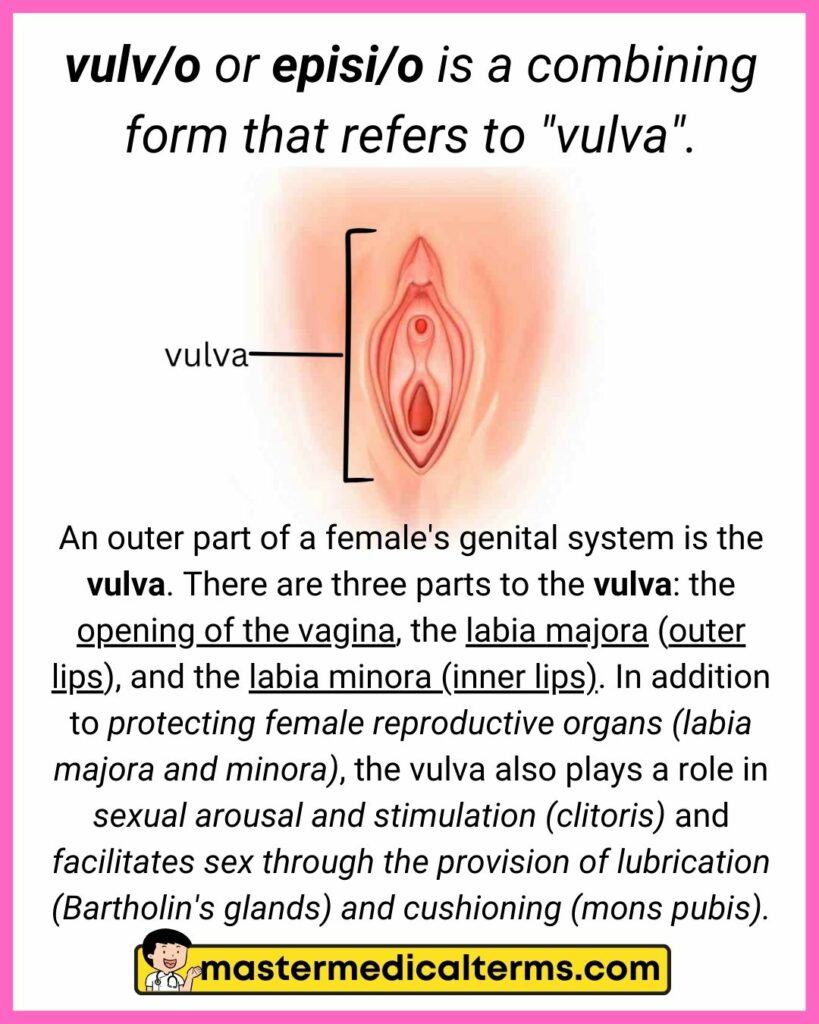By reviewing this flashcard review list, you will be able to identify and understand the female reproductive system’s combining forms and root words. Check out the quiz version of this flashcard if you want to see how much you remember.
#1 amni/o
amni/o is a combining form that refers to "amnion (amniotic sac)".
A thin-walled sac surrounds the fetus during pregnancy called an amniotic sac. In the amniotic sac, there is liquid (amniotic fluid) and a membrane enclosing the placenta on the fetal side (amnion). It safeguards the fetus from injury and maintains its temperature.
#2 cervic/o, trachel/o
#3 clitor/o, clitorid/o
#4 embry/o
#5 endometri/o
#6 fet/o
#7 gravid/o
#8 gyn/o, gynec/o
#9 hymen/o
hymen/o is a combining form that refers to "hymen".
A hymen is a thin, mucosal piece of tissue that wraps around or covers a portion of the external opening of the vaginal canal. It makes up a part of the external genitalia, also known as the vulva, and is structurally similar to that of the vagina.
#10 lact/o, galact/o
lact/o or galact/o is a combining form that refers to "milk".
For infants, breastmilk is the most nutritious food. With its safe, clean, and reliable antibodies, it can prevent several common childhood illnesses. For the first few months, breastmilk provides all the energy and nutrients an infant needs. It continues to do so for more than half of a child's nutritional needs for the second half of the first year.
#11 mamm/o, mast/o
mamm/o or mast/o is a combining form that refers to "breast (mammary gland)".
Mammary glands are highly evolved and specialized organs located on either side of the chest wall. Its primary function is to secrete milk. Despite being present in both sexes, it's more developed in women and much less developed in men.
#12 men/o
men/o is a combining form that refers to "menstruation".
Menstruation, or periods, are normal vaginal bleeding that happens every month. A woman's body prepares for pregnancy every month. In the absence of pregnancy, the uterus sheds it's lining. Menstrual blood is a mix of blood and some tissue from inside the uterus. Through the vagina, it leaves the body.
#13 nat/i
#14 oo, ov/o, ov/i
#15 ovari/o, oophor/o
ovari/o or oophor/o is a combining form that refers to "ovary".
The ovary is a female reproductive organ that releases eggs (ovum) and the hormones estrogen and progesterone. Female traits such as hair growth, breast development, and body shape are shaped by these hormones. Additionally, these hormones affect the cycle of menstruation and fertility.
#16 para
#17 pelv/i
pelv/i is a combining form that refers to "pelvis", "pelvic bones" or "pelvic cavity".
The pelvis is a basin-shaped bone that protects the abdominal organs and supports the spinal column. In the bony pelvis, there are two parts: the anterior and the posterior. In the anterior part of the pelvis, you find the pubis, the ischium, and the ilium. It is attached posteriorly to the pelvic spine. Coccyx and sacrum make up the pelvic spine.
#18 salping/o
#19 toc/o
#20 uter/o, metr/o, metr/i, hyster/o
#21 vagin/o, colp/o
#22 vulv/o, episi/o
vulv/o or episi/o is a combining form that refers to "vulva".
An outer part of a female's genital system is the vulva. There are three parts to the vulva: the opening of the vagina, the labia majora (outer lips), and the labia minora (inner lips). In addition to protecting female reproductive organs (labia majora and minora), the vulva also plays a role in sexual arousal and stimulation (clitoris) and facilitates sex through the provision of lubrication (Bartholin's glands) and cushioning (mons pubis).

























